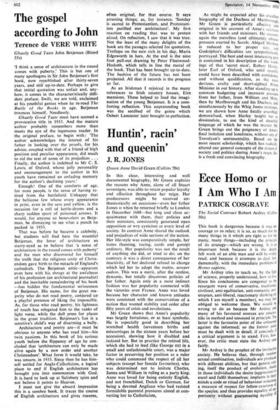The gospel according to John
Terence de VERE WHITE
Ghastly Good Taste John Betjeman (Blond 35s) 'I think a sense of architecture in the round comes with puberty.' This is but one of many apothegms in Sir John Betjetnan's first book, now republished after thirty-seven years, and still up-to-date. Perhaps to give that initial quotation was unfair and, any- how, it comes in the characteristically diffi- dent preface. Swift, we are told, exclaimed at his youthful genius when he re-read The Battle of the Books in age. Betjeman trounces himself. Needlessly.
Ghastly Good Taste must have seemed a provocative title in 1933. And the mature author probably remembers more than meets the eye of the ingenuous reader. In the original preface, to begin with: 'The author acknowledges the interest of his father in looking over the proofs, for his advice, coupled with that of a friend of high position and peculiar appearance, did much to rid the text of some of its prejudices . . Finally, the author is indebted to Mr C. S. Lewis, of Oxford, whose jolly personality and encouragement to the author in his youth have remained an unfading memory for the author's declining years.'
Enough! One of the comforts of age, for most people, is the sense of having re- tired from the battlefield. Unhappy that the bellicose few whose every appearance in print, even in the sere and yellow, is the occasion for a roll of kettle-drums and a sharp sudden spurt -of poisoned arrows. It would, for anyone so benevolent as Betje- man, be dismaying to see what a punch he packed in 1933.
That was before he became a celebrity, but students will find here the essential Betjeman, the lover of architecture so starry-eyed as to believe that 'a sense of architecture in the round comes with puberty' and the man who discovered for himself the truth that the religious unity of Christ- endom gave birth to the miracle of England's cathedrals. The Betjeman antic—apparent even here with his shrugs at the awfulness of his profession (an architectural journalist) and the inevitable remaindering of his book —has hidden the fundamental seriousness of Betjeman. His name, for the great ma- jority who do not read poetry, conjured up a playful pretence of liking the impossible. As, for those who read poetry, his lightness of touch has relegated him to the ranks of light verse, while the dull press for places in the great tradition. Betjeman's fun is a sensitive's child's way of disarming a bully.
Architecture and poetry are—it must be obvious to anyone who has read him—his twin passions. In this book of his serious youth before the flippancy of age .he con- cluded that 'architecture can only be made alive again by a new order and another Christendom'. What form it would take, he was unsure, in 1933. Since then he has him- self settled for Anglo-Catholicism, a logical place to end if English architecture has brought you into communion with God. It is hard to look up at Salisbury spire and not believe it points to Heaven.
I must not give the absurd impression this is a sombre book. It traces the course of English architecture and gives reasons, often original, for that course. It says arresting things; as, for instance, 'Sunday is sacred to Protestantism,, and Protestant- ism purified our architecture'. My first reaction on reading that was to protest aloud. On reflection, I saw that it was true. Not the least of the many delights of the book are the passages selected for quotation. Trollope on the new rich in his day, Maria Edgeworth in hers. At the end is the nine foot pull-out drawing by Peter Fleetwood- Hesketh, which tells in line the moral of the book. That has been brought up-to-date. The beehive of the future has not been projected. All that it records is the progress so far.
As an Irishman I rejoiced in the many references to Irish country houses, Eire mansions. These helped to feed the imagi- nation of the young Betjeman. It is a com- forting reflection. This unpretending book was the seedbed of the genre which Osbert Lancaster later brought to perfection.








































 Previous page
Previous page